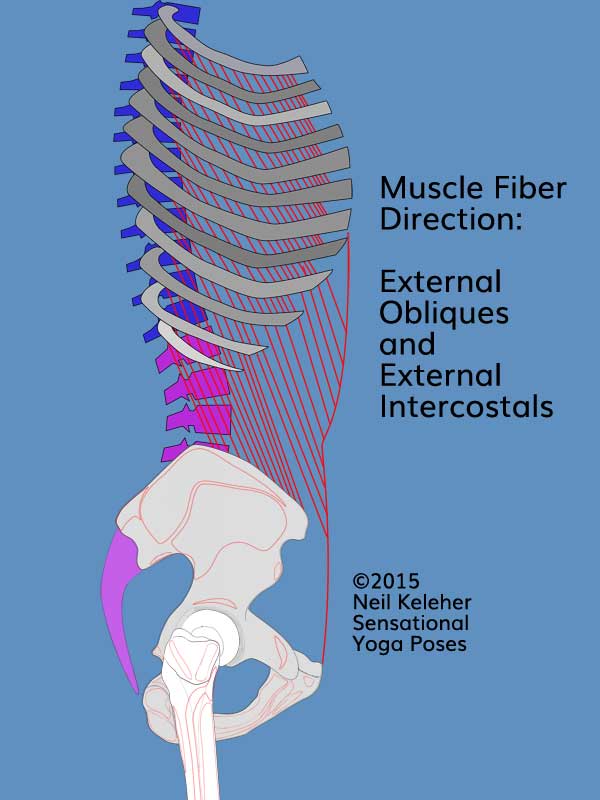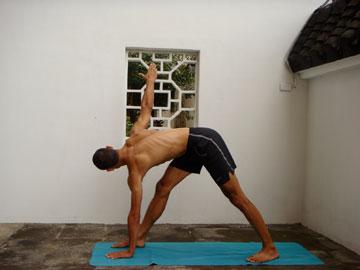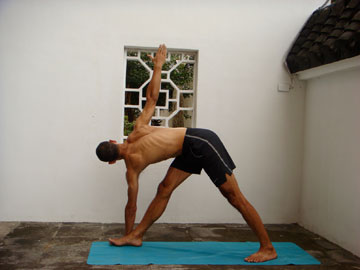To Twist or To Bend
If you activate the fibers of the external obliques on the right side of your body they'll pull the right side of your ribcage forwards relative to your pelvis.
If you hold your ribcage still then the fibers on the right side will pull the right side of your pelvis backwards relative to your ribcage.
When both sides are activated together, they'll pull your lower ribs (ribs 11 and 12) and middle ribs (ribs 7, 8, 9 and 10) forwards relative to your pelvis. At the same time they'll cause your sternum to lift and move away from your pelvis.
Using your external obliques and intercostals on both sides at the same time has a similiar effect to activating the spinal erectors. They all can be used to open up the front of the ribcage.
You may find that if you learn to feel and control your spinal erectors, obliques and intercostals, you'll be better able to control your breath and the shape of your ribcage and thoracic spine.
Sharing the Load with The External Obliques
As with the internal intercostals, the fibre angle of the external obliques carries on upwards into the external intercostals. (The intercostals are the muscle fibers that act on and are positioned between each set of ribs.)
Where the outer obliques pull the lower ribs forwards relative to the pelvis, the outer intercostals can be used to pull rib 10 forwards relative to rib 11 and rib 9 forwards relative to rib 10 and so on for all other rib pairs.
(Note that ribs are numbered from top to bottom. Rib 1 is the uppermost rib on each side of the body while rib 12 is the lower most.)
If the uppermost ribs are held stable then activating the external intercostals can help to slide each lower rib backwards relative to the rib above. Rib 7 then moves back relative to rib 6. Rib 8 moves back relative to rib 7 and so on. Likewise, if the ribcage is held static or still, then activating the external obliques can cause the pelvis to move back relative to the ribcage.
In each case, if you are sure of which part is stable, say the pelvis, then you can figure out in which direction the other part will move, say the ribcage or ribs.
Bending the Thoracic Spine (Shaping the Ribcage)
Because the ribs can be used like levers to act on the thoracic spine, both the internal and external obliques and intercostals can be used together to both twist the ribcage and also to bend the thoracic spine.
If you focus on keeping your pelvis still, you can use your external obliques to pull the middle ribs (ribs 8, 9 and 10) forwards relative to your pelvis. The external layer of the intercostals can assist in this. If the upper ribs remain where they are, then the middle thoracic vertebrae pull forwards while the upper vertebrae remain in place. The result is that your thoracic spine bends backwards.
This may be because as the ribs are pulled forwards relative to the pelvis, they lift at the same time. That lifting action when transmitted to all other ribs, helps to bend the ribcage as a whole backwards. This same action can be used to help cause an inhale.
The opposite action, pulling the ribs down, can be caused by using the internal obliques and intercostals. This action can cause an exhale.
Learning to Feel Your Obliques (and Intercostals)
The following exercises can be used to activate both internal and external obliques and intercostals.
First of all while sitting, either in a chair or cross legged on the floor, turn your ribcage to the right. Focus on pulling your left side ribs forwards. To activate your external obliques, focus on your lower and middle ribs (7 through 12, corresponding to the costal arch) and on moving them forwards relative to your pelvis.
Ideally, because your pelvis is either on the floor or a chair, your pelvis won't shift.
Once you can feel your external obliques activating (a squeezing feeling at the left side of your waist) then focus on moving your left side ribs relative to each other. Work your way from bottom to top, and feel the back, sides and front of your left side ribs, moving each higher rib successively deeper into the twist.
You may notice a feeling like your left side is being energized or feels alive.
You can rest and then do the same again trying to deepen both your awareness and your control, or you can try the turning to the left and activating your right side.
In both cases, try to vary the shape of your ribcage, bend it slightly forwards or backwards and try to find the shape where it is easiest to both turn your ribcage and twist it.
Once you can activate your external obliques and intercostals you can do the same exercise but focus on activating the internal layer of your obliques and intercostals.
Turning to the right, first focus on pulling the lower and middle right side ribs backwards. Then do the same with your ribs, pulling each successively higher rib further back. Then try to activate control and feel both sides of your waist and ribcage at the same time. Pull your left side ribs forwards and the right side back.
Rest and "unwind" and then do this on the other side.
One final tip with respect to twisting. To twist deeper you may find it helpful to also focus on feeling your thoracic vertebrae (these are the vertebrae to which the ribs attach) Feel your vertebrae and focus on them turning relative to each other.
To develop extra awareness and control try the same exercise while standing.
Have your feet hip or shoulder width apart and parallel and bend your knees slightly. Use your legs to keep your pelvis square to the front and then use your obliques and intercostals to turn and twist your ribcage.
Do both sides.
Next, turn your pelvis and ribcage together to the right. Keep your ribcage in place and then use your legs, obliques and intercostals to turn your pelvis to the front.
Using Your Internal and External Obliques in
Revolving Triangle (Parivrtta Trikonasana)
In twisting triangle, you can use your legs to keep your pelvis square, or at least stable, and then with one hand resting on the ground or on a block you can use your obliques and intercostals to turn your ribcage. You can use your lower hand to assist.
You can start out with your hand inside your front foot and then as your twist deepens move your hand outside your foot. To help open create space in your upper ribcage while doing this yoga pose, lengthen the back of your neck. You can also use your legs to push your pelvis back (while your ribs reach forwards.)
Published: 2020 08 28





